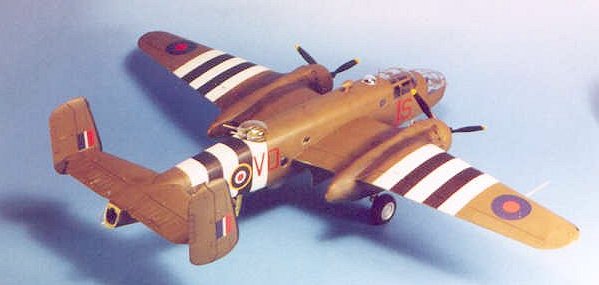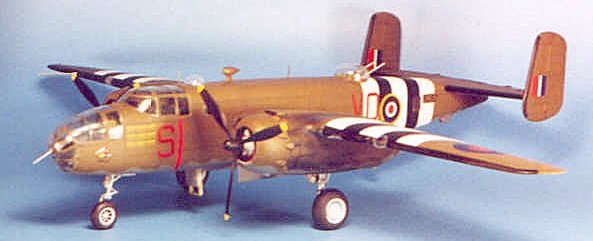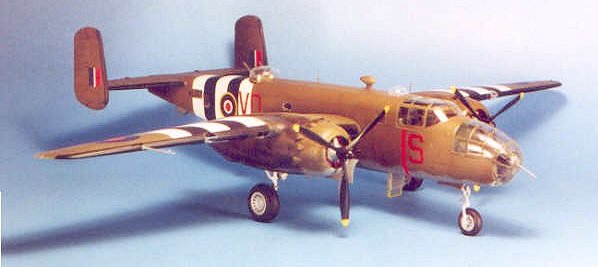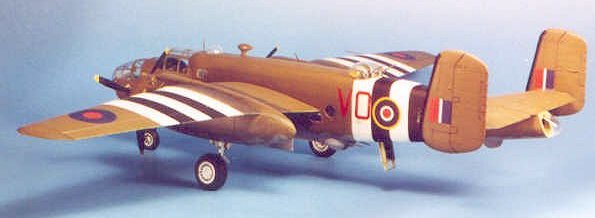
|
KIT # |
3431 |
|
PRICE: |
$40.00 |
|
DECALS: |
See review |
|
REVIEWER: |
|
|
NOTES: |
Falcon vac clear parts used |

|
HISTORY |
The North American B-25 Mitchell is one of the legendary aircraft of the Second World War. If the airplane had done nothing else but fly off the U.S.S. "Hornet" with Doolittle's Raiders to strike the Japanese homeland four and a half months after the sneak attack on Pearl Harbor, on April 14, 1942, its place in history would be assured.
The Mitchell fought on all fronts throughout the war, in the livery of several air forces. Built in larger numbers than any other U.S. medium bomber, it soldiered on through the years after the war. (Your reviewer can remember as a child being taken to Lowry AFB in Denver, and seeing row after row of TB-25J Mitchells lined up on the tarmac, and I believe I am the only professional air-to-air photographer to ever come close to taking a backwards swan dive out the aft escape hatch of a B-25, sans parachute.)
After the U.S.A.A.F., the air force that made the most use of the B-25 Mitchell was the RAF, who were the only air force to use the Mitchell in the ETO in any substantial numbers. Twenty-three of the B-25B were supplied as the Mitchell I; they would only be used to introduce RAF crews to the airplane as a trainer. Substantial quantities of the B-25C and D were supplied as the Mitchell II. The aircraft initially equipped 98 and 180 Squadrons in 2 Group - then part of Bomber Command - in late 1942. The Mitchell II flew its first combat mission in northeastern Europe on January 22, 1943, with a raid on an oil refinery in Belgium.
The Mitchells attacked tactical targets in northwestern France and the low countries throughout 1943, eventually equipping 226 Squadron RAF, 305 Squadron (Polish AF in the RAF), 320 Squadron (Royal Netherlands Air Force) and 342 Squadron (Free French Air Force). The Mitchells established a record of reliability and ability to absorb punishment yet return home during these missions. Throughout their combat in Europe, the Mitchells found their worst enemy was German flak, since they flew their missions at 8-10,000 feet in daylight; this was the prime altitude capability of the infamous "eighty-eight," and casualties were not light.
 In June 1943 the
Mitchell II squadrons in 2 Group were transferred from Bomber Command to 2nd
Tactical Air Force, the RAF's tactical air contribution to the invasion of
Europe. The Mitchells flew their missions in formations of two to six
squadrons, and the normal bombing altitude was 8,000 feet. In November, they
began striking the rail transport system throughout northwestern France and the
low countries. By January 1944, the mysterious ski-shaped structures discovered
in the Pas de Calais in the preceding December were identified as the future
launching sites of the V-1 flying bomb. Increasing numbers of sorties were
flown against these targets throughout the spring of 1944; these were known as "Noball"
strikes. Flak was the worst enemy, and some targets became well-known for the
accuracy and intensity of the defense, particularly over the "Noball" sites. In
April and May transportation targets were added to the list. Throughout this
period, the Mitchells of 2 Group regularly took worse losses than units of
Bomber Command flying over Germany.
In June 1943 the
Mitchell II squadrons in 2 Group were transferred from Bomber Command to 2nd
Tactical Air Force, the RAF's tactical air contribution to the invasion of
Europe. The Mitchells flew their missions in formations of two to six
squadrons, and the normal bombing altitude was 8,000 feet. In November, they
began striking the rail transport system throughout northwestern France and the
low countries. By January 1944, the mysterious ski-shaped structures discovered
in the Pas de Calais in the preceding December were identified as the future
launching sites of the V-1 flying bomb. Increasing numbers of sorties were
flown against these targets throughout the spring of 1944; these were known as "Noball"
strikes. Flak was the worst enemy, and some targets became well-known for the
accuracy and intensity of the defense, particularly over the "Noball" sites. In
April and May transportation targets were added to the list. Throughout this
period, the Mitchells of 2 Group regularly took worse losses than units of
Bomber Command flying over Germany.
Following the Normandy invasion, the Mitchells began flying night missions - this was due to the fact that enemy transport only operated at night, and due to the fact that there were no fighters to escort the bombers and there was a need to try and cut down on losses.
Throughout the advance across northwestern France, the Mitchells were called on to strike targets just ahead of the advancing armies, which they accomplished despite sometime appalling flak opposition. This continued as the Commonwealth armies turned and attacked into the Low Countries that fall. 98 Squadron took particularly heavy casualties in bombing raids to support the paratroop assault in Operation Market Garden that September.
During the Battle of the Bulge, the Mitchell squadrons flew every day possible in terrible weather conditions, striking enemy concentrations wherever they could be found.
In November 1944, Mitchell III (B-25J) aircraft began arriving in the squadrons to replace losses. By February 1945 - when the B-25C/D had been universally replaced in combat operations by American units around the world - Mitchell IIs were still a third of the 2TAF squadrons. The last Mitchell II left 98 Squadron - the original Mitchell unit in the RAF - on March 18, 1945. Between the invasion in June 1944 and V-E Day eleven months later, the Mitchell squadrons of the RAF suffered cumulative losses of over one hundred percent, equivalent to that suffered on the ground by infantry units of the allied forces.
|
THE KIT |
 The Accurate
Miniatures B-25C/D Mitchell, which followed the B-25B Mitchell in release in
2000, was the first 1/48 early Mitchell to be produced by a major kit
manufacturer since the Revell B-25B was released in the late 1960s. Overall,
with a few mistakes, the kit was head-and-shoulders above anything else
available. Thanks to the rivet-counters of the "serious" internet modeling
crowd, who determined that the cowlings were not "open enough" and that the
glass nose was "mis-shapen" (something like a scale inch-and-a-half low), these
"experts" declared the model "unbuildable" and sales suffered accordingly among
the demographic the kit was aimed at.
The Accurate
Miniatures B-25C/D Mitchell, which followed the B-25B Mitchell in release in
2000, was the first 1/48 early Mitchell to be produced by a major kit
manufacturer since the Revell B-25B was released in the late 1960s. Overall,
with a few mistakes, the kit was head-and-shoulders above anything else
available. Thanks to the rivet-counters of the "serious" internet modeling
crowd, who determined that the cowlings were not "open enough" and that the
glass nose was "mis-shapen" (something like a scale inch-and-a-half low), these
"experts" declared the model "unbuildable" and sales suffered accordingly among
the demographic the kit was aimed at.
When Accurate Miniatures went out of business last year, their stock on hand went to the highest bidder. Most of the available B-25C/D kits did not have clear plastic parts, which created a problem for anyone hoping to sell the kits. Greatmodels Webstore, which purchased the majority of these kits, made a deal with Falcon Vacuforms - who make the best vacuform canopies available anywhere - to produce clear parts for these kits. This model is built with those parts to demonstrate to modelers what is possible.
|
CONSTRUCTION |
Overall, the construction of this kit is entirely similar to that of the B-25B which was reviewed here two years ago (and if that isn't enough, here is the editor's B-25G review, Ed). While I put in the interior detail of the rear fuselage, I personally think it is a waste of time, since not one piece of it can be seen through any window or other clear area available. Unlike those who are happy to say "I don't care of you can't see it, I know it's there," I am a big believer in the concept of "if you can't see it, I didn't do it." Life is too short for the former attitude, so far as I am concerned. (To each his own, but if you're in the first group, don't complain you can't seem to get any models finished.)
 Construction of the
kit is straightforward, though I do not think the vacuformed windows fit as well
as they could, and the vacuformed turrets are a pain in the assets when it comes
to fitting them to their structures. Take a deep breath, test fit and test fit
again, and yet again if necessary. In the end they look OK, but I found myself
wishing the original kit clear parts were available. They aren't, so deal with
it. It can be done.
Construction of the
kit is straightforward, though I do not think the vacuformed windows fit as well
as they could, and the vacuformed turrets are a pain in the assets when it comes
to fitting them to their structures. Take a deep breath, test fit and test fit
again, and yet again if necessary. In the end they look OK, but I found myself
wishing the original kit clear parts were available. They aren't, so deal with
it. It can be done.
Is the nose glass of the Falcon kit more accurate than that of the original kit glass? I don't know. I compared the model with a photo I once took of "Photo Fanny," the Air Museum's B-25 photo ship, and "it looked close enough to me."
I "Futured" all the Falcon glass parts and attached them during assembly. They were then masked off using Scotch Invisible Tape, since the AM masks are no longer included in the kit.
|
PAINT & DECALS |
Painting:
I chose to do an RAF airplane for two reasons: I wanted to do a B-25 with invasion stripes and there were no USAAF groups that participated, and I have a beautiful John Dibbs (is there any other kind?) air-to-air shot of the restored Mitchell II in England - the only one of its kind in the world that flies - carrying these markings.
Many people have thought that RAF B-25C/D Mitchell IIs were painted in RAF colors. Not true!! No one knew as the airplanes went down the production line which airplane was going to who. They all came out of the paint shop in US Olive Drab 41 over Neutral Grey 43. As to what color RAF Mitchell IIIs were - after the B-25J started coming out of the factory in natural metal finish in the summer of 1943 - I am open to an argument they weren't in OD/NG, but could have been in RAF Dark Green over Sea Grey Medium, painted in the UK after delivery. That question doesn't apply here.
 I "pre-shaded" the
model, applying black over the entire area of what would be the D-Day stripes.
I masked the black stripes, and painted the white stripes; doing this allowed
the white stripes to look a bit "ratty," which they do in all photos I have seen
of Mitchell IIs so marked.
I "pre-shaded" the
model, applying black over the entire area of what would be the D-Day stripes.
I masked the black stripes, and painted the white stripes; doing this allowed
the white stripes to look a bit "ratty," which they do in all photos I have seen
of Mitchell IIs so marked.
Once the stripes were masked off, I painted the lower surfaces in Tamiya XF-53 "Neutral Grey," thinned 50-50 with rubbing alcohol. I painted the upper surfaces with Gunze-Sanyo H-52 "Olive Drab." I lightened this color with Tamiya XF-60 "Dark Yellow" and Gunze Sanyo H-49 Violet to get the kind of fading of Olive Drab experienced in the ETO, where sun-fading of aircraft on the ground basically didn't happen. I used more of the Tamiya Dark Yellow because these airplanes did not fly at the altitudes where the Olive Drab would be as strongly influenced by ultraviolet radiation as those aircraft that normally operated above 20,000 feet.
When all was dry, I futured the model and was ready for decals.
Decals:
There is no aftermarket sheet I am aware of that has markings for a Mitchell II. I used a variety of sheets from the decal dungeon, including upper wing Type B roundels for the Hawker Hurricane, standard C.1 fuselage roundels, and standard fin flash decals. The Squadron codes came from a ModelDecal sheet, and the bomb missions from the AMT sheet for the old Otaki Corsair, cut appropriately. The airplane badge came from a Mosquito sheet, because I saw an airplane in Chris Shores' 2TRAF book that had something similar.
|
CONCLUSIONS |
I built the B-25B Doolittle Raider model and liked that two years ago. I like this kit. The vacuform glass is not easy to use, but if you take your time and Future it so you can use cyanoacrylate glue safely, you can get everything where it belongs. If you want to buy all the Meteor/Cutting Edge Resin aftermarket parts to "make it really really right," you can have fun and get a Mitchell you will like. There are aftermarket sheets available for SWPA strafers in cool markings. (Editor's note; If you are fortunate enough to have the G conversion set, then it comes with a full set of plastic clear bits and probably enough extras to do both the G and C/D.)
Copyright ModelingMadness.com
If you would like your product reviewed fairly and fairly quickly, please
contact
the editor or see other details in the Note to
Contributors. Back to Reviews Page
2019